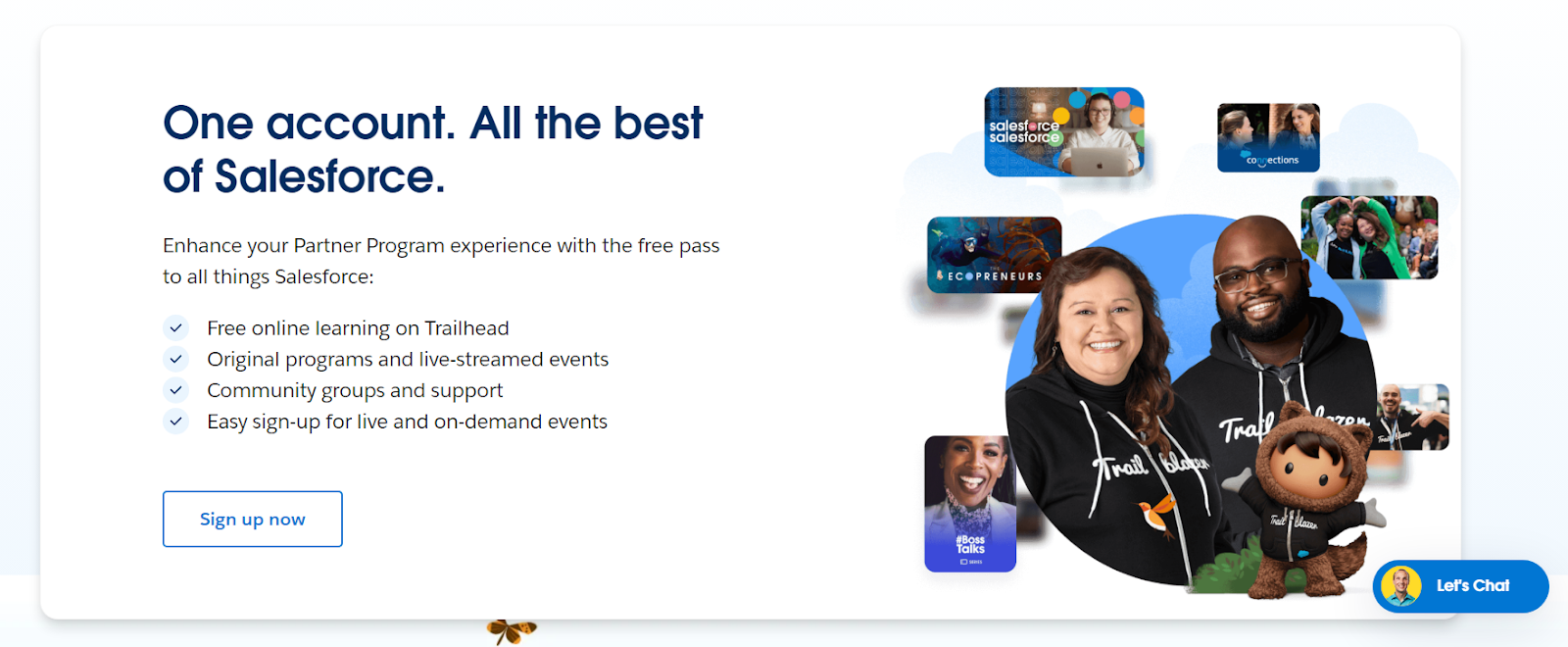
Building meaningful collaborations with other businesses can help you achieve growth. A partner program is one of the most effective ways to collaborate with others and expand your reach. This strategy involves creating mutually beneficial relationships with other businesses to achieve shared goals and grow your audiences.
Combining your talents and resources with a partner company unlocks new opportunities. Together, you can give customers more value and tap into new markets. This article offers an in-depth look at partner programs and tips to help you get started.
Introducing partner programs
A partner program is a formal relationship between two or more businesses. These companies agree to work together to achieve common goals. They also draw on each other’s knowledge, resources, and strengths.
For example, suppose you sell RV accessories. You could ask RV dealerships to carry your accessories at their locations. In exchange, you’ll give them a small percentage of each sale. These collaborations let you reach clients who may not find your business on their own.
Partner programs offer many benefits, including:
- Boosting sales
- Expanding into new markets
- Getting new revenue sources
- Growing your customer base
- Increasing leads
- Offering new product bundles
- Pooling knowledge and resources
- Raising brand awareness
Partnering with another company can also help you grow your business faster. You can tap into their existing customer base instead of starting from scratch. Plus, you can rely on their expertise for a shorter learning curve.
Types of partner programs
There are four main types of partner programs. Some companies use all four kinds, but you may only need one or two, depending on your goals.
1. Integration and technology partnerships
Clients often want all their technology to work together. Integration and technology partnerships can help you meet this demand. These programs combine products or services into one solution to create a more seamless user experience.
Businesses typically partner with technology companies that offer complementary services. For example, the Salesforce partner program helps companies integrate their programs with the Salesforce platform.

You may need to work with your partners to create shared databases, application programming interfaces (APIs), and other interfaces. These tools let you share data and build compatible systems. An experienced integration partner can guide you through this process.
2. Channel partnerships
A channel partner sells your products and services on your behalf. They receive a cut of the profits for every sale they make. Some people refer to these partnerships as indirect sales.
Channel partnerships let you expand into new markets with less investment. Your partner will advertise your products and services to their existing clients. That way, you can spend less on marketing. You also won’t need to set up new locations or hire new staff. Instead, you can rely on your partner’s existing resources.

In 1955, McDonald’s and Coca-Cola formed one of the most famous channel partnerships. McDonald’s agreed to exclusively sell Coca-Cola beverages in all its restaurants. In exchange, Coca-Cola promised not to sell its products to McDonald’s competitors at lower prices. The fast food chain has also operated out of global Coca-Cola offices as it expanded to new regions.
3. Strategic partnerships
Strategic partnerships are long-term relationships between two companies working toward the same goal. These collaborations can take many forms depending on the partners’ strategies. For example, you could collaborate to develop products or marketing campaigns. Some companies also form community partner programs for charitable causes.
In 2018, Nike partnered strategically with the nonprofit organization Girls Inc. This group offers services for girls ages six to 18 across the United States and Canada. Nike supports Girls Inc.’s Sporting Chance program to encourage girls to participate in sports and get active.
4. Brand affiliates
Brand affiliates are individuals who promote your products or services. They typically post ads for your brand on their social media or websites. These ads have tracking links that let you see how many clients visit your website and buy something. You’ll pay a flat fee or commission for every sale or lead your affiliates net.
Affiliate marketing is more informal than channel partnerships. You may have dozens or hundreds of affiliates who share your products. However, they work independently and don’t help companies reach common goals. In other words, they’re short-term contractors, not long-term business partners.
Tens of thousands of affiliates take part in the Amazon partner program. They share products and earn up to 10% commission from qualifying purchases.
Establishing a successful partner program
There’s no one-size-fits-all approach to setting up a partner program. It’s important to tailor your approach to fit the goals and needs of you and your partners. Still, these basic steps can help you create a strong foundation.
Find the right partners for business growth
In many ways, a partner program is like a marriage. You and your partner have a shared vision for your future and are committed to supporting each other. Your partner can also affect your finances and reputation. That’s why it’s essential to pick your collaborators carefully.
Ask yourself these questions as you consider potential partners:
- Do we have compatible business goals and values?
- What is their customer base?
- Do they have a positive reputation?
- Has this company successfully collaborated with other partners before?
- Are they eager to invest time and money into your partnership?
- Are they financially stable?
- What resources do they have?
- Does their staff have strong communication and project management skills?
Don’t hesitate to turn down partnerships that seem like the wrong fit. Like in marriage, it’s better to hold out for your ideal partner than get stuck in a bad relationship.
Build win-win relationships
Like any good relationship, a partnership program should benefit both parties. That way, each partner will feel valued and invested in the success of the collaboration.
Create a win-win scenario by working with your partner to develop shared goals. These goals should fit both businesses’ strategic priorities.
Examples of shared goals include:
- Cross-sell products and services
- Improve the customer experience
- Expand into new markets
- Build brand awareness
- Organize industry events together
- Launch a shared marketing campaign
Develop formal processes
Create formal processes at the beginning of your partnership so everyone is on the same page.
You can start by creating clear communication channels between your businesses. You could choose a point person for your partner to contact if they need information or help. You should also ask for regular progress reports to make sure everyone stays on track to meet your goals.
It’s also essential to standardize procedures and workflows. Work with your partner to create common guidelines and templates, such as standard contracts for new clients and data-sharing policies.
Additionally, you may need to train your partner so they can represent your business effectively. For instance, you could give them brand guidelines to use in marketing. You could also create an online webinar to teach their sales team how to pitch your products.
Offer ongoing support
Successful partnerships are long-term investments. You need to offer continuous support if you want your collaboration to thrive. It may be helpful to create a dedicated support team for your partner. You should also help your collaborator overcome challenges and offer resources as needed.
Planning your partner program
These preliminary steps can help you plan successful collaborations after you’ve found partners.
Optimize for common customer segments
Account mapping helps you and your partner compare clients and opportunities. You can use this process to find overlapping customer segments.
For example, suppose you and your partner have a large audience of teenage girls. You can target this demographic to cross-sell your products and increase sales.
Define timeframes and revenue expectations
Partnership programs often don’t achieve overnight success. After all, it takes time to build meaningful relationships and develop shared processes. As a result, you may not see success for a year or longer.
Work with your partner to define clear timeframes and milestones. You can also use predictive analytics software to set revenue expectations. These steps help make sure everyone has realistic expectations for the program.
Secure executive buy-in
Executive buy-in ensures you have the time you need to build relationships. Set clear expectations upfront and explain your timeline. You should also give frequent progress reports. These updates will help your leaders understand the value of your partnerships.
Implementing partner management software
Partner program software will help you reach your goals and improve your collaborations.
Constant Contact offers many tools to streamline partnerships:
- Our Enterprise Program lets you create consistent branding for your partnerships. You can also track performance with our data analytics tools.
- Our Business Partner Program lets partners earn revenue or give their clients discounted access to the platform.
- Our Agency Program simplifies client management for digital marketing agencies and freelancers. You can develop marketing campaigns, share revenue, and collect data.
Constant Contact’s email marketing automation software lets you communicate with your partners. For instance, you can send regular emails with updates and industry news. You can also create shared email lists to reach clients.
Building and launching a partner program
These simple steps can help you turn your partner program from an idea to a reality.
Defined program structure and goals
Creating shared goals is the first step to developing a successful partnership. These goals could include:
- Boosting sales
- Generating new leads
- Improving customer satisfaction
- Building brand authority
- Making an impact on the community
- Integrating technology
Your goals can help you determine the best structure for your program. If you want to integrate your software, you might work together to create a shared ecosystem. Or, you might prefer a channel partnership to reach new markets.
Application processes and terms setting
Some companies allow other businesses to apply to become their partners. This process lets you choose from interested applicants instead of cold-calling potential collaborators. Add an application form to your website for contact information and other details.
You should also create clear terms for your partners. Be sure to outline expectations, performance metrics, legal requirements, etc.
Software selection and asset creation
Streamline your collaborations with partner program software. Look for a platform with the features you need. For example, data analytics tools will help you track your performance.
You’ll also need to gather assets for your partners. These resources could include training programs and branding guidelines.
Outbound partner search and partner support
Networking can help you find new partners. Consider attending industry conferences and other events to make connections. You could also browse LinkedIn and company websites for leads.
Finally, you’ll need to support your partners. Offer onboarding so they can learn about your company’s expectations. You can also send regular emails with advice and updates.
Ensuring a win-win scenario
Work with your partners to create strategies that benefit both of you. Focus on shared goals that help both companies grow.
Additionally, it’s essential to provide value for your partner. For instance, you could pay a commission for sales from your referral partner program. Or you could promote their brand in your social media and email marketing campaigns.
Finally, you can use case studies as inspiration for your programs. The alliance between Barnes & Noble and Starbucks is one famous success story. Barnes & Noble lets the coffee chain operate inside many of its bookstores. Customers are more likely to read and buy books when they can sip coffee during their visit — meanwhile, Starbucks benefits from increased sales.
Future directions in partner programs
Partner programs can help you grow your reach and achieve your goals faster. There are several types of partnerships, including channel and strategic collaborations. Choosing the right structure will help you get the most out of your partnerships.
Get started by selecting a partner who sells complementary products or services. For example, if you sell workout gear, you could partner with a gym franchise. If you run a small farm, you might collaborate with local restaurants. These partnerships can open new opportunities and connect you with new clients.




